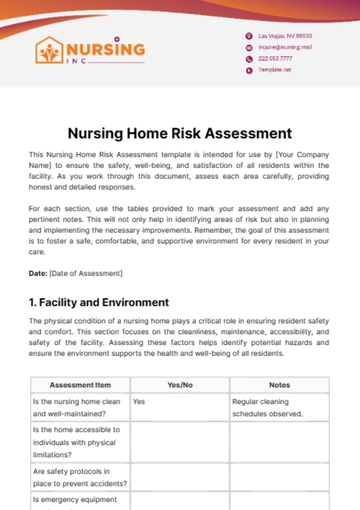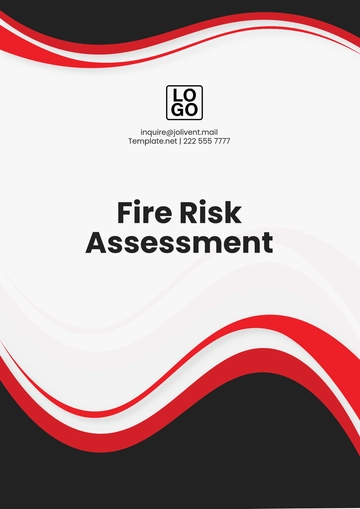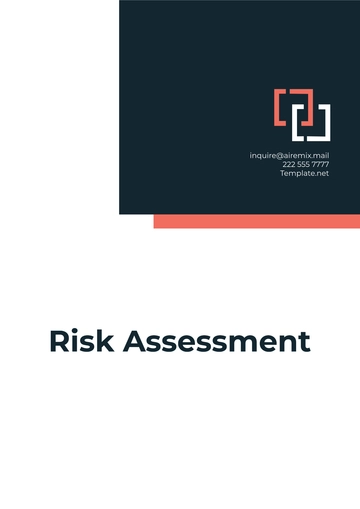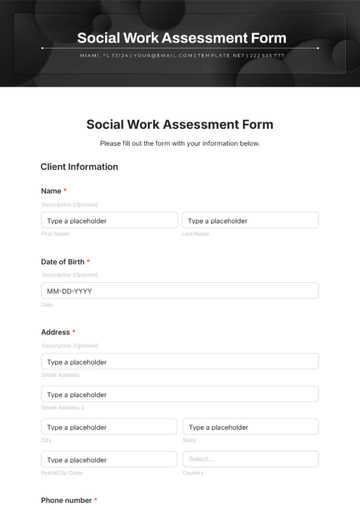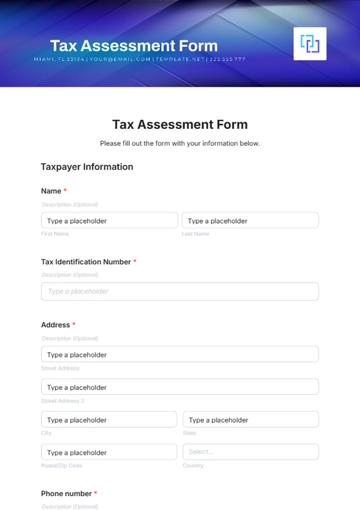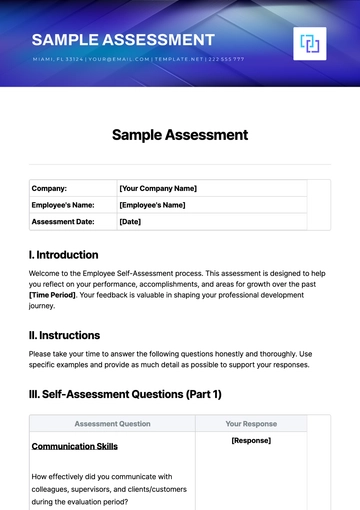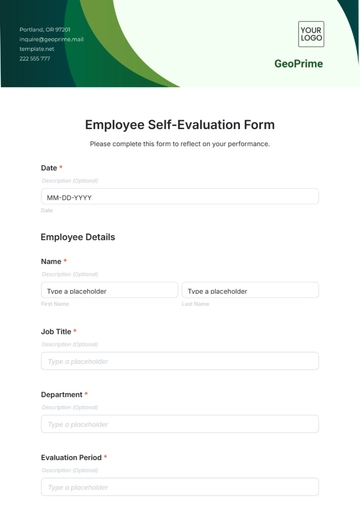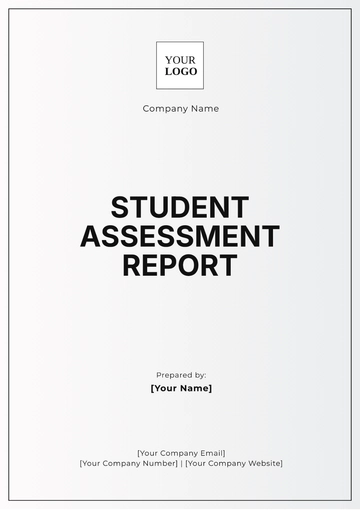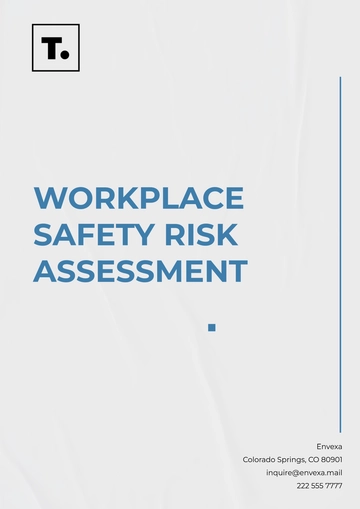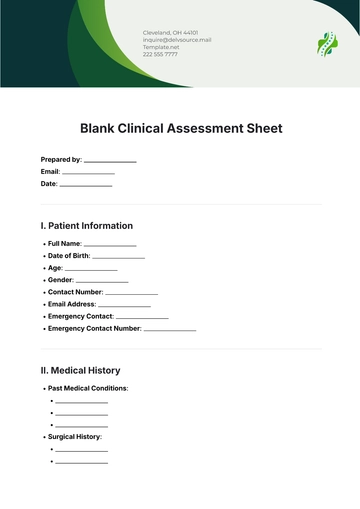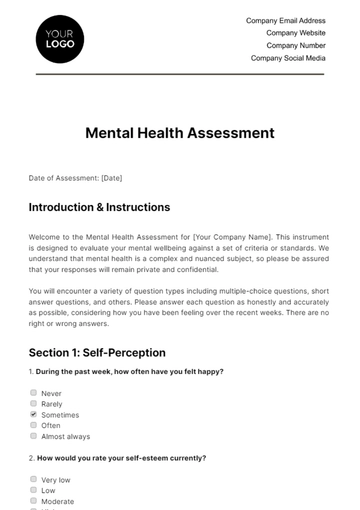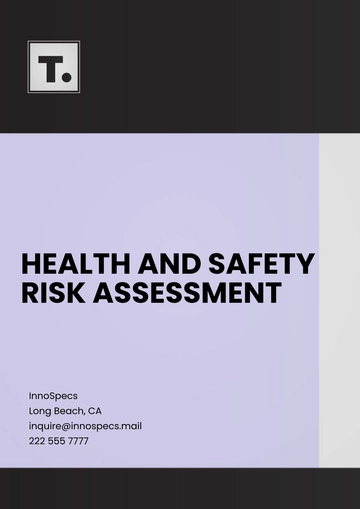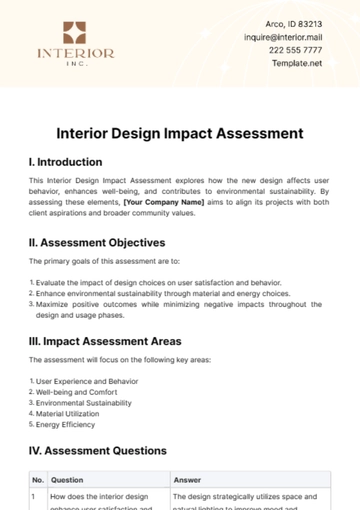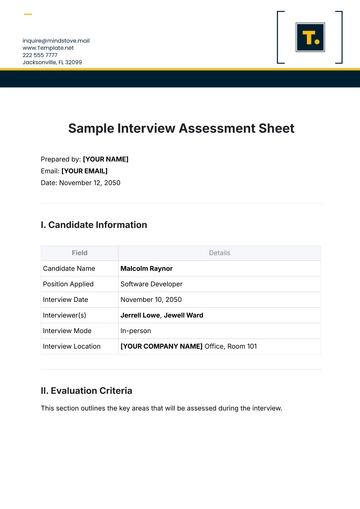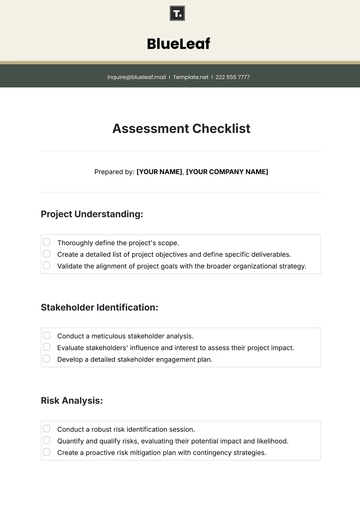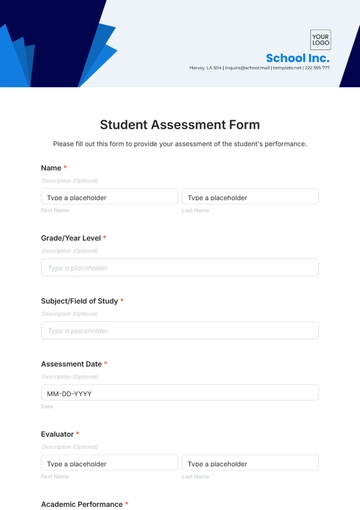Free Workplace Harmony Assessment HR
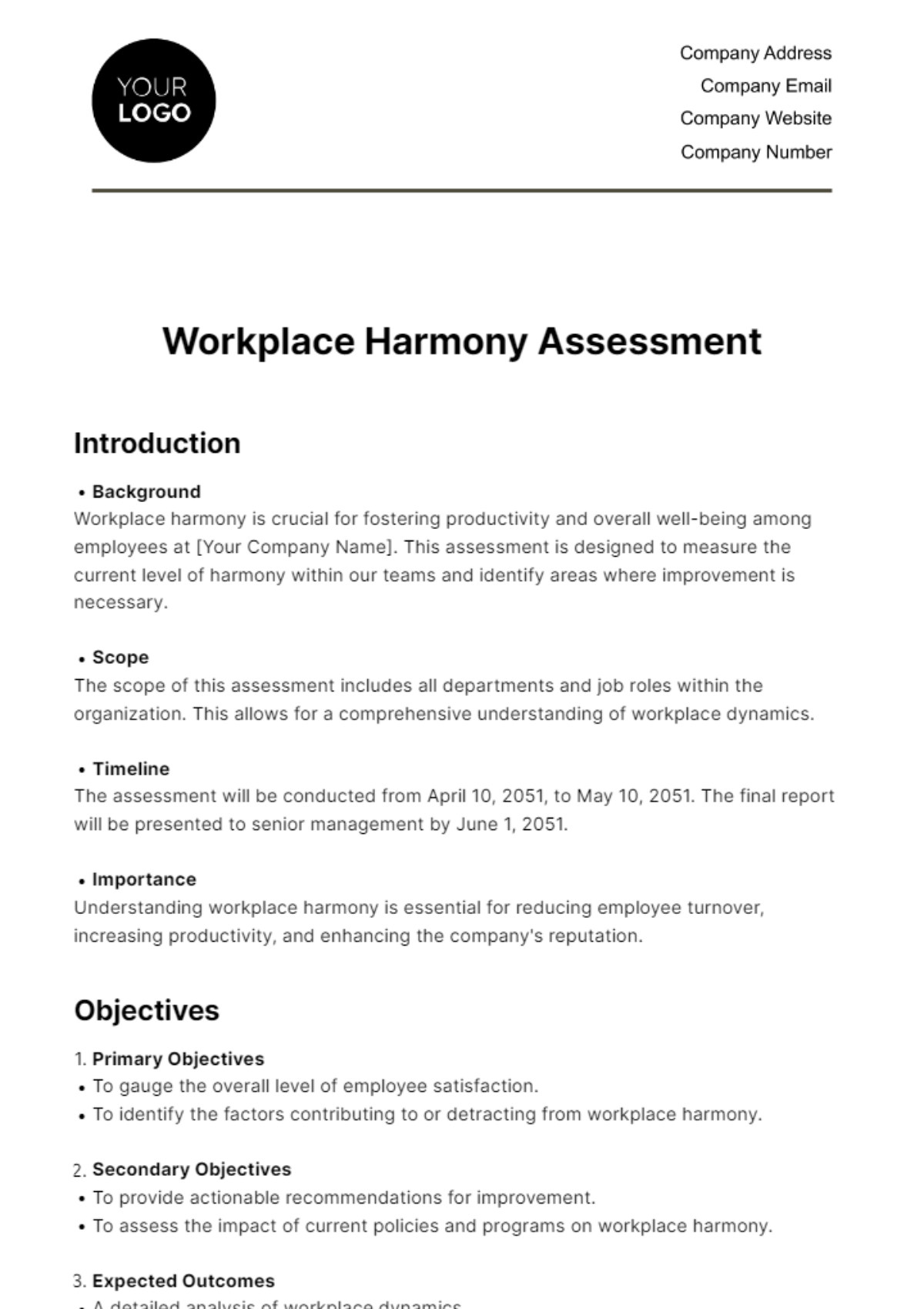
Introduction
Background
Workplace harmony is crucial for fostering productivity and overall well-being among employees at [Your Company Name]. This assessment is designed to measure the current level of harmony within our teams and identify areas where improvement is necessary.
Scope
The scope of this assessment includes all departments and job roles within the organization. This allows for a comprehensive understanding of workplace dynamics.
Timeline
The assessment will be conducted from April 10, 2051, to May 10, 2051. The final report will be presented to senior management by June 1, 2051.
Importance
Understanding workplace harmony is essential for reducing employee turnover, increasing productivity, and enhancing the company's reputation.
Objectives
Primary Objectives
To gauge the overall level of employee satisfaction.
To identify the factors contributing to or detracting from workplace harmony.
Secondary Objectives
To provide actionable recommendations for improvement.
To assess the impact of current policies and programs on workplace harmony.
Expected Outcomes
A detailed analysis of workplace dynamics.
A set of recommendations aimed at enhancing workplace harmony.
Assessment Criteria
Quantitative Criteria
Employee turnover rate
Absenteeism rate
Productivity metrics
Qualitative Criteria
Employee satisfaction surveys
Interpersonal relations
Team cohesion
Key Performance Indicators (KPIs)
Employee Net Promoter Score (eNPS)
Team collaboration ratings
Methodology
The methodology section outlines the approach and methods used for this Workplace Harmony Assessment at [Your Company Name]. A well-designed methodology is crucial for ensuring that the data collected is both accurate and actionable.
Data Collection Methods
Surveys
Online surveys were distributed to all employees to gauge their overall satisfaction and perception of workplace harmony. These surveys consisted of both multiple-choice and open-ended questions to provide a comprehensive view.
Interviews
Personal interviews were conducted with selected employees from various departments. The aim was to dig deeper into specific issues that may not be fully captured by surveys alone.
Observation
Members of the HR department performed observational assessments in different work settings, including team meetings, social events, and day-to-day interactions among staff.
Data Sources
HR Records
HR records provided key metrics such as employee turnover rate, absenteeism, and internal employee performance reviews.
Employee Feedback
Employee feedback gathered through surveys and interviews formed the qualitative aspect of our assessment.
Observational Data
Notes and summaries from the observational assessments were analyzed to identify patterns or trends that could influence workplace harmony.
Sampling Methods
Random Sampling for Surveys
For the online surveys, a random sampling technique was used to ensure that every employee had an equal chance of participating. This approach helps in reducing selection bias.
Stratified Sampling for Interviews
Stratified sampling was employed for the interviews to ensure that employees from all levels and departments were represented. Within each stratum, participants were selected randomly.
Targeted Observation
While observations were largely unstructured, special attention was given to settings that had been frequently cited in previous employee feedback as problematic for workplace harmony.
Sample Size and Confidence Level
A 95% confidence level was aimed for, with a confidence interval of 5%. The sample size for surveys and interviews was determined based on these statistical parameters to ensure the reliability of our results.
Employee Survey Results
The survey was sent to all employees across different departments and roles. We received an 80% response rate, which is a robust indicator of employee engagement and interest in improving the workplace environment.
Key Findings
Satisfaction Level Overview
The overall satisfaction level, on a scale of 1 to 100, averaged at 70%.
Factor | Satisfaction Level (%) |
Work-Life Balance | 80 |
Interpersonal Relations | 60 |
Departmental Satisfaction Breakdown
Different departments demonstrated varying levels of satisfaction. For instance, the IT department scored higher on work-life balance, whereas the Sales department showed room for improvement in interpersonal relations.
Gender and Age Group Analysis
No significant variations in satisfaction levels were noted across different gender and age groups, indicating a generally inclusive work environment.
Response Rate
With an 80% response rate, the data collected provides a reliable representation of the workplace environment. The high response rate also shows employee willingness to participate in company-wide initiatives for improvement.
Employee Comments
Various comments were received that highlighted the need for better communication between management and staff. Several employees also mentioned the lack of team cohesion, particularly in project-based roles.
Data Analysis
Quantitative Data Analysis
Employee Turnover Rate
With a 5% turnover rate, our organization is performing well compared to the industry average. However, exit interviews reveal that workplace harmony is a factor for leaving the company.
Absenteeism Rate
A 2% absenteeism rate indicates that most employees are engaged, but it still signifies a minor issue that needs to be addressed.
Productivity Metrics
90% of projects were completed on time. Productivity seems to be positively correlated with high workplace harmony scores.
Qualitative Data Analysis
Work-Life Balance
Employees are largely satisfied with their work-life balance but suggest more flexible work arrangements could improve this further.
Interpersonal Relations
Issues regarding interpersonal relations were identified in the Sales and Marketing departments. Reports include conflicts and lack of cooperative behavior.
Cross-Analysis
In comparing quantitative and qualitative metrics, departments that reported higher satisfaction levels also showed lower absenteeism and higher productivity levels.
Recommendations
Short-term Recommendations
Team-building Exercises
It is advised to conduct team-building exercises to improve interpersonal relations.
Flexible Work Hours
A pilot program of flexible work hours is recommended for roles that do not require strict on-site presence.
Anonymous Feedback Channels
Setting up anonymous channels can help in gathering more candid feedback from employees, which can be critical for making necessary adjustments.
Long-term Recommendations
Policy Revisions
A complete review and potential revision of company policies regarding workplace harmony and employee relations are needed.
Mentorship Program
Implementing a mentorship program can help in acclimating new employees and providing growth paths, which can improve workplace satisfaction.
Annual Assessments
Conducting these assessments annually will help in continuously monitoring and improving the work environment.
Action Plan
An action plan with quarterly milestones should be developed to implement these recommendations. Each department head will be responsible for meeting these milestones.
Conclusion
The assessment has highlighted both strengths and weaknesses in the current workplace environment. While the overall state of workplace harmony at [Your Company Name] is satisfactory, specific areas require immediate intervention.
Maintaining and improving workplace harmony is an ongoing effort that requires the commitment of every employee. Immediate actions based on this assessment can set the stage for a more harmonious and productive work environment.
For further queries, please contact:
[Your Name]
[Your Email]
[9999999999]
[blueberry_digital_labs]
- 100% Customizable, free editor
- Access 1 Million+ Templates, photo’s & graphics
- Download or share as a template
- Click and replace photos, graphics, text, backgrounds
- Resize, crop, AI write & more
- Access advanced editor
Promote a harmonious workplace with our Workplace Harmony Assessment HR Template. This tool offers a systematic approach to evaluating the overall harmony and collaboration within your organization, enabling HR professionals to identify areas for improvement and implement targeted interventions. Secure your copy today and foster a more positive and collaborative work environment.


